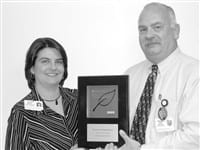Form and Function Oncoplastic Surgery Gives Breast-cancer Patients Another Choice
Breast-cancer surgery is always an anxious time, and the decision between a mastectomy and a lumpectomy often a difficult one. Now women have yet another choice.
It’s called oncoplastic surgery, and it offers some women the opportunity to have cancerous tissue removed and their breast repaired cosmetically — all in one surgery.
“We borrowed a few techniques from plastic surgeons, from augmentation to lifts, to use in breast-cancer patients,” said Dr. Susan Cash, a breast surgeon at Baystate Medical Center. “We have the ability to remove cancer with good margins, and we’ve observed decreased recurrence rates with a much more cosmetically acceptable breast.”
Traditionally, women with breast cancer would have the cancerous tissue removed by one surgeon — through either a lumpectomy or mastectomy — and later undergo a separate procedure with a plastic surgeon for repair or reconstruction.
But oncoplastic surgery essentially merges the two fields. Cash and Dr. Holly Mason, Baystate’s director of Breast Surgical Services, are among a slowly growing number of cancer surgeons becoming trained in these cosmetic techniques that better preserve the breast’s shape with fewer procedures and less trauma.
Fewer Complications
Breast cancer afflicts one out of eight American women at some point in their lives. Making plans for breast reconstruction at the same time as cancer surgery, some doctors say, can speed a woman on the path of recovery, both physical and psychological. Combining procedures may also reduce the risk of complications from successive surgeries.
In a typical lumpectomy, the surgeon makes an incision, removes the cancerous tissue, and then closes the opening, which often leaves the breast with a disfiguring dent. In oncoplastic surgery, however, a wedge is removed, and then tissue under the skin is pulled together to close the defect.
Doctors who pioneered the procedure say it not only maintains the shape of the breast, but usually its sensation and lactation capabilities as well. An oncoplastic approach may be taken by two surgeons teaming up to do cancer removal and reconstruction in the same operation.
“You need a dedicated breast surgeon willing to do these techniques and to have good relationship with a plastic surgeon in order to take care of these patients with oncoplastic techniques,” said Mason.
Many women will want to follow up the surgery with a cosmetic reduction of the other breast to even out the size and shape. Mason added, however, that some women’s breasts are asymmetrical to begin with, and occasionally oncoplastic surgery will bring them more into proportion than before.
Mason said that most cancer surgeons are accustomed to doing lumpectomies for small cancers and mastectomies for larger ones, but oncoplasty has provided an option of removing a larger cancer without the trauma of mastectomy.
It’s important, Mason said, for surgeons to be able to take out the cancer but also manipulate tissue so that the breast, while smaller than before, still retains a natural shape.
“It’s an enhanced lumpectomy,” Cash said. “What we do depends on where the cancer lies in the patient. There are several options for how we can approach it, based on the size of the patient, how big the cancer is, and where it’s located.”
In some cases, she added, chemotherapy is recommended first, in order to shrink the tumor down to a size that will allow an oncoplastic lumpectomy.
Pioneer in the Valley
Baystate is among the few hospitals in the Northeast with cancer surgeons trained in oncoplasty, but Cash said the procedure is gaining traction across the country. She and Mason traveled to Baylor University in Dallas to receive specialized training.
“For these women, the alternative is either mastectomy or lumpectomy, both of which may result in a significant breast deformity,” said Dr. Mia Talmor, assistant attending surgeon at the Breast Center of the Iris Cantor Women’s Health Center at New York-Presbyterian, interviewed for the hospital’s Web site. “After surgery, both breasts will look the same, and look no different from breasts that have been reduced for strictly cosmetic reasons.”
Of course, doctors must consider more than aesthetics whtn guiding patients in their decision-making process. “We’re very much committed to keep things cosmetically nice,” Mason said, “but at the end of the day, cancer surgeons must adhere to the principles of minimizing risk and reoccurrence.”
Still, many cancer patients do have choices, and Mason is happy to add another one to the list.
“We’re trying to reduce our rate of mastectomies, but some patients actually choose mastectomy over lumpectomy for their own comfort level,” she added. “We certainly respect the patient’s wishes. The nice thing is that we also have newer technologies for doing mastectomies to minimize scarring.”
“We’re giving patients more options,” Cash said.



